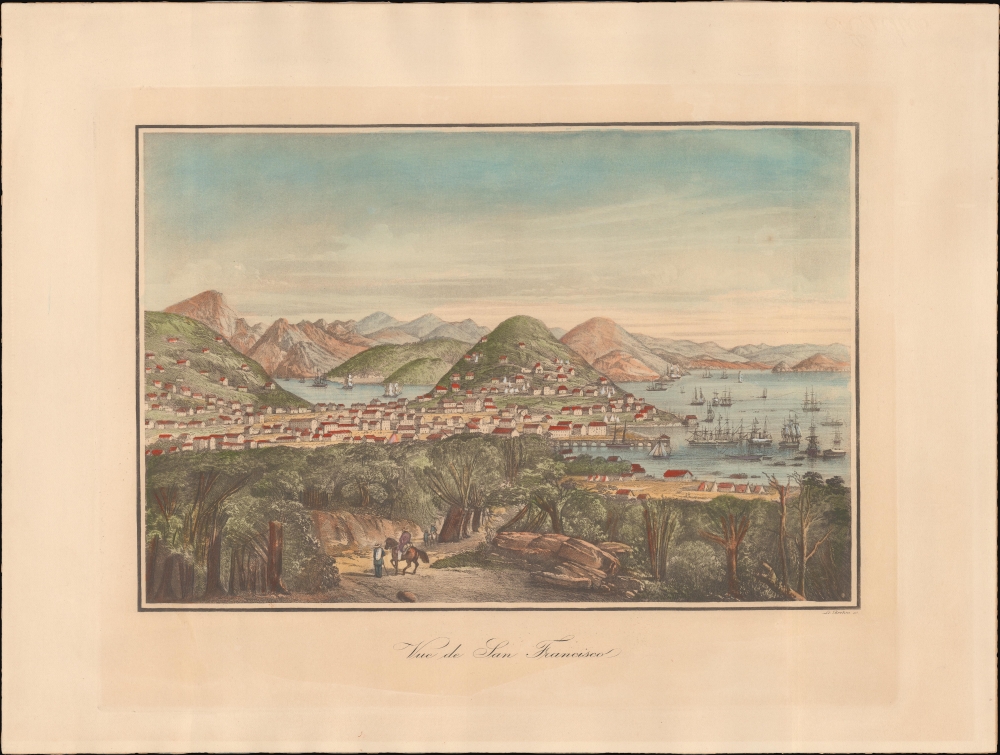1854 / c. 1910 Le Breton View of San Francisco, California
VuedeSanFrancisco-lebreton-1854-2
Title
1854 (undated) 9.5 x 14.5 in (24.13 x 36.83 cm)
Description
A Closer Look
This view illustrates San Francisco in the hey-day of the California Gold Rush, not long after it joined the United States. This view looks to the north, with Telegraph Hill at center, Russian Hill to the left, and Alcatraz Island, Angel Island, and what is now Marin County in the background. Gold prospectors, with their pitched tents, and the rugged wilderness surrounding the city are alluded to in the foreground. In the wake of the Mexican-American War (1846 - 1849) and the California Gold Rush (1849), the world was eager for information about California and San Francisco more specifically.The Early Days of San Francisco
Prior to the California Gold Rush, San Francisco had been a distant outpost of Spanish and then Mexican authority in California, containing a fortress (presidio) and Catholic mission (Misión San Francisco de Asís), both founded in the late 18th century, and a small settlement known as Yerba Buena. Aside from the Spanish and Native American population, occasional European explorers or traders visited, including Russian traders from Fort Ross, now in Sonoma County to the north of the city.In 1846, a group of Mormon settlers doubled the settlement's population, heralding the waves of migrants from the east who would soon descend upon the area. The Mexican-American War brought greater attention to the city, rechristened San Francisco during the conflict, but it was of course the discovery of gold at Sutter's Mill, California that changed San Francisco's fortunes forever. The city's population increased 25 times over between 1848 and 1850, and continued to grow steadily afterwards, becoming the main Pacific port of the United States.
Publication History and Census
This view was prepared by the French painter Louis Le Breton, depicting the city in the early 1850s. The dating of this view is highly uncertain, with galleries and dealers listing it with dates ranging from 1848 to 1876, and potential later editions into the 20th century. Le Breton is also credited with a larger format print of the same view, titled 'San Francisco, vue prise d'un point élevé du côte Sud,' also quite rare. The present work bears a strong resemblance to Theodore Taylor Johnson's View of San Francisco, showing the city in 1850 (sanfrancisco-johnson-1850), though it is unclear which work was published first. The present view is only known to be held by the University of California Berkeley (Charlotte Cerf Cushing collection of prints and watercolors) and is scarce to the market, while the larger format first edition is held by Stanford University, the University of California Berkeley, and the Amon Carter Museum of American Art.Cartographer
Louis Le Breton (January 15, 1818 - August 30, 1866) was a French medical doctor and maritime painter active in the middle part of the 19th century. He was born in Douarnenez,, France to a long line of doctors. He studied medicine at the L'École de Médecine de la Marine de Brest (1837 - 1837), subsequently joining the navy as surgeon. Le Breton is notable for having taken part in the third Jules Dumont d'Urville (1790 - 1842) voyage (1837 - 1841). He initially joined the expedition on board the Astrolabe as a surgical assistant. Breton was distantly related to d'Urville and leveraged his family connections for a place on the prestigious circumnavigation. In the early days of the expedition, Le Breton befriended the expedition's official painter, Ernest Goupil (1814 - 1840), under whom he studied marine painting, quickly exhibiting a natural proficiency. In 1840, when Goupil died of dysentery in Hobart, Tasmania, Le Breton took over the artist's official duties. When the voyage returned to Paris, he was knighted as a Chevalier de la Légion d'Honneur and on D'Urville's recommendation worked in subsequent years compiling the Atlas du Voyage for D'Urville's official account. He returned to the sea in 1844 on board the Cradle, again as a surgeon, returning to Paris in 1846. From 1847, he dedicated himself fully to painting, formally resigning his naval commission in 1848. Afterwards, he worked as a draftsman and engraver, famously producing graphic illustrations of demons for Collin de Plancy's Dictionnaire Infernal. Le Breton died in Paris of cholera in 1866. More by this mapmaker...

